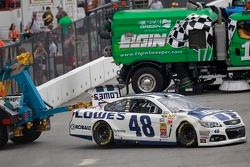Could tire sensors stop air pressure shenanigans?
Goodyear provides recommended air pressures but teams continue to push the limits

Eric Gilbert
















On Sunday, Jimmie Johnson found himself sidelined prematurely at Pocono Raceway once again.
The culprit? A right front tire.
At several tracks this season, teams have experienced issues with tire failures – and the six-time Sprint Cup champion certainly hasn't been immune to those issues.
Repeat offender
At New Hampshire two weeks ago, the No. 48 had two left-rear tires failures in the first 11 laps, the second of which put him out of the race.
Although Johnson protested, “I can promise you one thing, it wasn’t due to low left rear tire pressure," Goodyear had a different diagnosis after examining the tires. As was the case with Joey Logano and Aric Almirola earlier in the weekend, Goodyear believed the tire failures were due to low air pressure.
Each week Goodyear makes minimum air pressure recommendations. But teams don’t always adhere to the numbers. Such was the case at Auto Club Speedway where a rash of cars experienced tire failures – including Johnson's.
On flatter tracks, such as Pocono, Auto Club Speedway and New Hampshire Motor Speedway, teams often get overly aggressive with camber (angle of the tire) and air pressures in an effort to improve the car’s grip.
Establishing transparency
So if the teams don’t follow the suggested minimum air pressures, how does Goodyear protect itself against the negative publicity when a driver has a blowout?
How about a tire sensor to discourage teams from fudging on their numbers?
“We’ve talked to NASCAR about different things like that,” Greg Stucker, director of race tire sales for Goodyear, told Motorsport.com. “We worked on those on and off for several years, but it’s come more to the forefront in our discussions with how they’re looking at their new officiating.
We worked on those on and off for several years, but it’s come more to the forefront in our discussions with how they’re looking at their new officiating
Goodyear's Greg Stucker on the use of tire senssors
“But no decisions have been made whether or not we’re moving forward on that. We’re doing research and trying to figure out what our options might be in a situation like that, but nothing for sure.”
Stucker says a tire pressure monitor on a race car would use the same technology to report psi “no different than what you see on your street car these days."
The sensors could be wheel- or tire-mounted, but Stucker added there was “a shield (or inner liner) to deal with” which would add complexity to the process. NASCAR teams currently use a wheel mounted sensor for testing but the monitors are not allowed during race weekends.“
"The concept would offer the driver or the team feedback instantaneously as far as air pressures,” Stucker said.
By the book
NASCAR sets minimum pressures each week for the right-front tires. At Indy and Pocono, there are also minimum pressures for the front left side tires as well.
When issues popped up at ACS, NASCAR vice president Robin Pemberton acknowledged, "Over the past few years we've been on a path to add mechanical grip, give more options to the teams. We've opened up camber rules for grip in both the front and the rear of the car. They have a lot of tools to use if they choose to do so...If they have too much camber and abuse the tires, that's what happens."
They have a lot of tools to use if they choose to do so...If they have too much camber and abuse the tires, that's what happens
NASCAR VP Robin Pemberton
Pemberton complimented Goodyear's selection of tires at Fontana. The recommended tire pressure at ACS was 22 pounds. Pemberton says some teams went as low as 14 pounds. NASCAR routinely monitors the cold pressures prior to the tires going over the wall.
Next generation
Stucker added that the new tire combination introduced at Indianapolis was well received.
The left -side tires had not been raced at the Brickyard in the past. Goodyear recommended higher air pressures – a four-psi increase on the lefts and five psi on the right front due to the new Gen-6 car carrying higher loads on a single tire.
“Overall everything looked good,” Stucker said. “We were about where we thought we’d be from a speed perspective. Temperatures were under control. We were a little down on grip, but we knew that would be the case going in. It was all within the range that was manageable.”
Be part of Motorsport community
Join the conversationShare Or Save This Story
Subscribe and access Motorsport.com with your ad-blocker.
From Formula 1 to MotoGP we report straight from the paddock because we love our sport, just like you. In order to keep delivering our expert journalism, our website uses advertising. Still, we want to give you the opportunity to enjoy an ad-free and tracker-free website and to continue using your adblocker.



















Top Comments